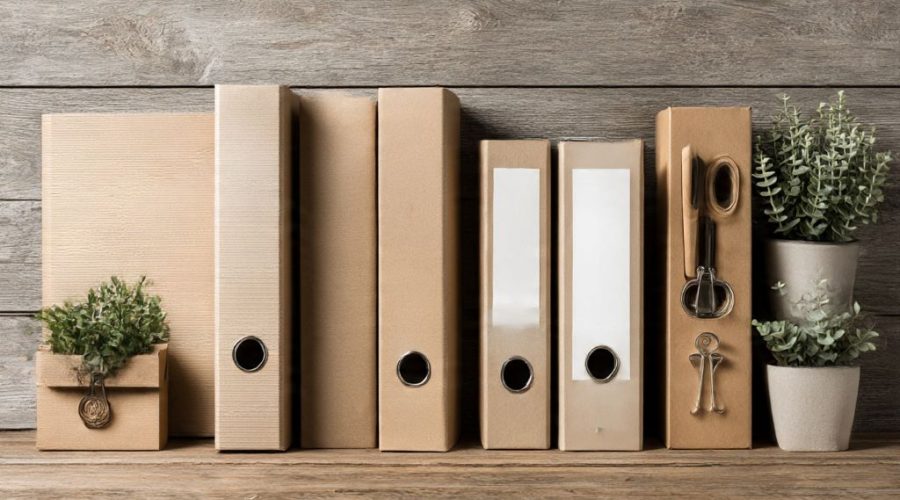Understanding the Zero Waste Office Movement
The modern workplace is experiencing a significant transformation as businesses recognize their environmental impact. More companies are adopting zero waste principles to reduce their carbon footprint and create healthier work environments. This shift goes beyond simple recycling programs, extending to every aspect of office operations, including how we organize and store documents.
According to Mech Office, a leader in sustainable office solutions, the average office worker uses approximately 10,000 sheets of paper annually. However, the environmental concern extends beyond paper consumption to include the filing systems and organizational tools we use daily. Traditional office supplies often contain harmful plastics and non-recyclable materials that contribute to landfill waste. Therefore, implementing sustainable filing solutions has become essential for environmentally conscious businesses.
Choosing Non Plastic Paper Binders for Your Office
One of the most impactful changes you can make is switching to non plastic paper binders for your document organization needs. These innovative alternatives offer the same functionality as conventional binders while significantly reducing environmental harm. Traditional plastic binders take hundreds of years to decompose and release toxic chemicals during production. In contrast, eco-friendly binders use materials like recycled cardboard, sustainably harvested wood, and plant-based components that naturally biodegrade.
Additionally, these sustainable options often feature metal rings and clips that can be easily removed and recycled separately. Many manufacturers now create binders from reclaimed materials, giving new life to what would otherwise become waste. The durability of quality non-plastic binders matches or exceeds their plastic counterparts, making them a smart long-term investment for any organization.
Materials That Make a Difference
Understanding the materials used in sustainable filing solutions helps you make informed purchasing decisions. Several eco-friendly options have emerged as viable alternatives to plastic-based products. Each material offers unique benefits while supporting zero waste goals.
Recycled cardboard binders provide excellent strength and can withstand regular office use. These products often incorporate post-consumer waste, reducing demand for virgin materials. Cork represents another sustainable option, as it’s harvested from tree bark without harming the tree itself. Cork naturally regenerates, making it an infinitely renewable resource.
Hemp-based binders offer exceptional durability and require minimal water and pesticides during cultivation. This fast-growing plant produces strong fibers perfect for creating long-lasting office supplies. Bamboo has also gained popularity due to its rapid growth rate and natural antibacterial properties. Furthermore, some innovative companies now produce binders from agricultural waste like wheat straw and sugarcane fiber.
Implementing a Zero Waste Filing System
Creating an effective zero waste filing system requires thoughtful planning and commitment. Start by auditing your current office supplies to identify items that need replacement. Gradually transition to sustainable alternatives rather than discarding usable products, as this approach aligns with zero waste principles.
Establish clear organizational protocols that minimize paper use while maintaining efficiency. Digital filing systems should complement rather than completely replace physical storage, as some documents require hard copies for legal or practical reasons. However, implementing a “digital first” policy significantly reduces overall paper consumption.
Consider adopting a color-coding system using natural dyes or inherently colored materials to eliminate the need for plastic tabs and labels. Reusable cloth labels or wooden tags provide excellent alternatives to plastic identifiers. Moreover, investing in quality sustainable products from the start prevents frequent replacements and reduces waste over time.
The Economic Benefits of Sustainable Office Solutions
Many businesses hesitate to adopt eco-friendly alternatives due to perceived higher costs. However, sustainable office supplies often provide better value over time. Quality non-plastic binders typically last longer than cheap plastic versions, reducing replacement frequency and associated costs.
According to research from the Environmental Protection Agency, businesses that implement comprehensive waste reduction programs save an average of $1,500 per employee annually through reduced supply costs and waste management fees. These savings accumulate quickly, especially in larger organizations. Additionally, many sustainable suppliers offer bulk purchasing discounts that make eco-friendly options competitively priced with conventional products.
Employee productivity often increases in environmentally conscious workplaces. Studies show that workers feel more engaged and satisfied when their employers demonstrate commitment to sustainability. This improved morale translates to better performance and reduced turnover costs.

Creative Storage Solutions Beyond Traditional Binders
Zero waste filing extends beyond binders to encompass comprehensive document management strategies. Wooden filing boxes crafted from reclaimed lumber provide attractive desktop storage while eliminating plastic components entirely. These boxes can be customized with natural finishes and offer superior durability compared to plastic alternatives.
Metal filing systems represent another excellent option for long-term document storage. Steel and aluminum cabinets last decades and maintain their functionality through years of heavy use. When properly maintained, these systems never need replacement, embodying the ultimate zero waste principle of longevity.
Fabric file folders made from organic cotton or hemp offer flexible storage for frequently accessed documents. These washable folders eliminate the need for disposable plastic sleeves and can be repaired rather than replaced when worn. Similarly, natural fiber magazine holders and document trays bring organizational functionality without environmental compromise.
Training Your Team on Sustainable Practices
Successfully implementing zero waste filing solutions requires team-wide participation and understanding. Conduct training sessions that explain the environmental impact of traditional office supplies and demonstrate proper use of sustainable alternatives. Make the learning process engaging by sharing success stories and measurable outcomes from your sustainability initiatives.
Create easy-to-follow guidelines for document management that incorporate zero waste principles. Post visual reminders near filing areas to reinforce proper practices. Additionally, designate sustainability champions within each department who can answer questions and encourage consistent participation.
Recognize and celebrate milestones in your zero waste journey to maintain momentum and enthusiasm. Share regular updates about waste reduction achievements and cost savings to demonstrate tangible results from everyone’s efforts.
Conclusion
Transitioning to zero waste office filing solutions represents a meaningful step toward environmental responsibility. By choosing non-plastic paper binders and other sustainable alternatives, businesses reduce their ecological footprint while often improving functionality and achieving long-term cost savings. The variety of available eco-friendly materials ensures that every office can find solutions matching their specific needs and budget. Implementation requires initial planning and team education, but the benefits extend far beyond waste reduction to include improved employee morale and enhanced corporate reputation. Start your zero waste journey today by evaluating current filing systems and gradually introducing sustainable alternatives that align with your organizational values.
Frequently Asked Questions
Are non-plastic binders as durable as traditional plastic ones?
Yes, quality non-plastic binders often exceed the durability of plastic alternatives. Materials like recycled cardboard with reinforced corners, bamboo, and hemp withstand regular office use for years. The key is selecting well-constructed products from reputable manufacturers rather than cheapest available options.
How much does transitioning to zero waste filing solutions cost?
Initial investment varies depending on current inventory and chosen alternatives. While some sustainable products carry higher upfront costs, their longevity typically results in lower total ownership costs. Many businesses find that bulk purchasing and gradual transition strategies make the switch financially manageable while achieving long-term savings.
Can I recycle my old plastic binders before switching to eco-friendly options?
Most plastic binders cannot be recycled through standard curbside programs due to mixed materials and metal components. However, many office supply retailers offer recycling programs specifically for old binders. Remove metal rings for separate recycling, and check with local waste management facilities for plastic recycling options.
What happens to eco-friendly binders at end of life?
Sustainable binders made from natural materials typically biodegrade or can be composted depending on specific composition. Metal components should be removed and recycled separately. Many manufacturers provide take-back programs or specific disposal instructions to ensure proper end-of-life handling.
Do zero waste filing solutions work for high-volume document storage?
Absolutely. Many sustainable filing systems are designed specifically for high-volume commercial use. Metal filing cabinets, reinforced cardboard archive boxes, and quality non-plastic binders handle substantial document collections effectively. The key is selecting appropriate products for your specific volume and access frequency requirements.
Related Topics:

